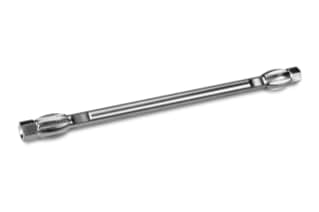
|
Chemistry |
C18 |
|
Separation Mode |
Reversed Phase |
|
Particle Substrate |
Hybrid |
|
pH Range Min |
2 pH |
|
pH Range Max |
11 pH |
|
Maximum Pressure |
6000 psi (415 Bar) |
|
Endcapped |
Yes |
|
Bonding Technology |
Shield RP18 |
|
Silanol Activity |
Low |
|
Particle Shape |
Spherical |
|
Particle Size |
3.5 µm |
|
Endfitting Type |
Waters |
|
Pore Size |
130 Å |
|
Format |
Column |
|
Surface Area |
185 |
|
System |
HPLC |
|
Particle Technology |
BEH |
|
USP Classification |
L1 |
|
Inner Diameter |
4.6 mm |
|
Length |
150 mm |
|
Carbon Load |
17 % |
|
UNSPSC |
41115709 |
|
Brand |
XBridge |
|
Product Type |
Columns |
|
Units per Package |
1 pk |
XBridge BEH Shield RP18 Column, 130Å, 3.5 µm, 4.6 mm X 150 mm, 1/pk
For scientists who want to achieve excellent peak shape, higher efficiency, and excellent stability for both acidic and basic mobile phases, the Waters XBridge BEH Shield RP18 columns offer maximum flexibility in HPLC methods development. Allowing for robust separations to be developed in shorter times with greater confidence, the XBridge BEH Shield RP18 column combines the cutting edge bonding, end-capping, and particle synthesis of these columns with the innovative BEH particle technology created by Waters.
XBridge BEH Shield RP18 Columns that contain embedded polar groups have been rising in popularity among methods development scientists because of their alternate selectivity compared to the traditional chemistries of C18. XBridge BEH Shield RP18 columns offer complementary selectivity in addition to superior peak shapes for bases. By implementing Waters’ patented Shield Technology, they are able to incorporate a carbamate group embedded into the bonded phase, which “shields” surface silanols. This ability also allows compatibility with fully aqueous mobile phases while eliminating the risk of pore dewetting, resulting in reliable and robust retention. Shield Technology provides stable and reproducible analyte retention times in 100% aqueous mobile phases.
Utilizing the alternate selectivity and ability to operate over a broad pH range of the XBridge BEH Shield RP18 columns, chromatographers will be able to quickly optimize the necessary test conditions to achieve successful separations. Polar and basic analyte retention factors are generally reduced while non-polar analytes remain mostly unaffected. When it comes to bases, the Shield Technology reduces silanol interaction with basic analytes, leading to highly efficient and symmetrical peaks.
All BEH XBridge columns utilize the Ethylene Bridged Hybrid (BEH) particle developed by Waters. The small-pore trifunctionally-bonded BEH particle allows for a wide usable pH range with superior low pH stability and ultra-low column bleed in proteomics, peptide mapping, and synthetic peptide applications.
Browse Waters’ wide selection of quality lab equipment that is perfect for use in your work, such as the VanGuard Cartridge Holder, 1/pk.
What solvents should be used with the XBridge Shield RP18 columns?
In order to achieve maximum column performance, high-quality chromatography grade solvents should be used and all aqueous buffers should be filtered in advance. Waters recommends Pall Gelman Laboratory Acrosdisc filters. Any solvents that contain suspended particulate materials can clog the outside surface of the inlet distribution frit of the column, resulting in higher operating pressure and poor performance. All solvents should be degassed before use to avoid bubble formation in the pump or detector. It is recommended to use an on-line degasser, especially when running low-pressure gradients.
What is BEH Technology?
At the core of UPLC technology lies the 1.7 µm BEH (Ethylene Bridged Hybrid) particle, serving as a pivotal catalyst. These particles, available in diverse pore sizes and bonded phases, facilitate the implementation of both reversed-phase and hydrophilic interaction chromatography. This versatile technology finds application in the analysis of a broad spectrum, ranging from small molecules to large molecule biopharmaceuticals. Hybrid particle technology has intrinsic chemical stability, allowing for a wider usable pH range [pH 1-12]. This also enables a versatile, robust separation technology for method development. The BEH particle technology is available in a variety of HPLC particle sizes [2.5, 3.5, 5, and 10 µm] which allows for a seamless transition between HPLC and UPLC technology platforms.